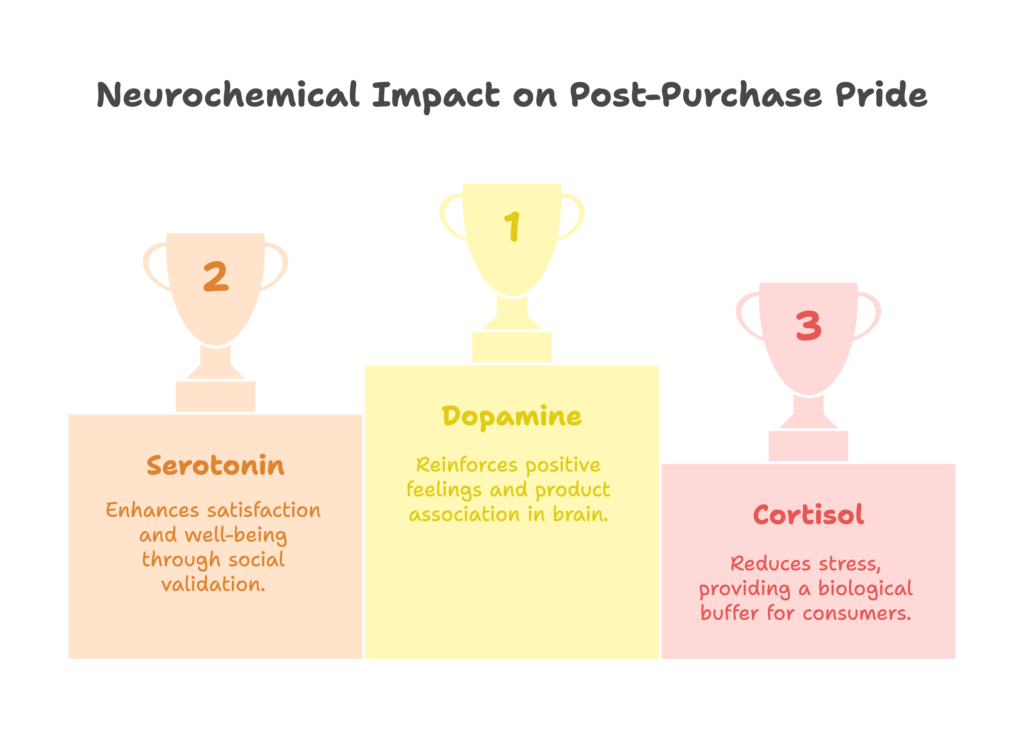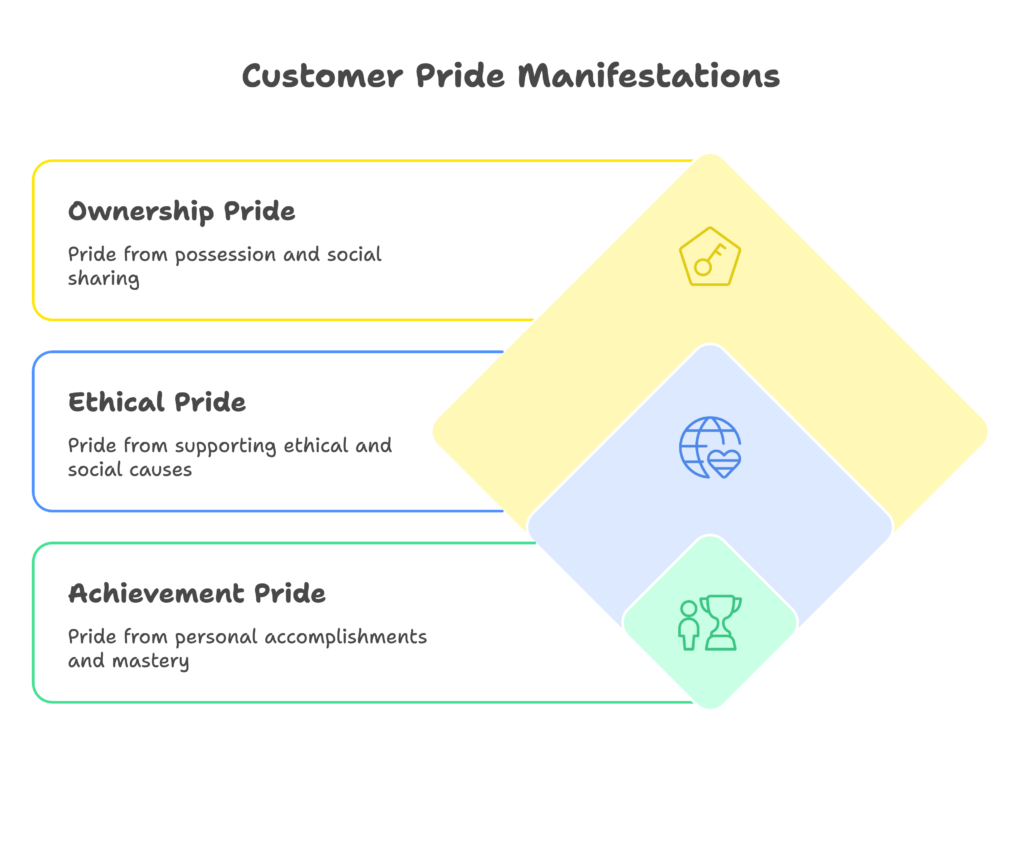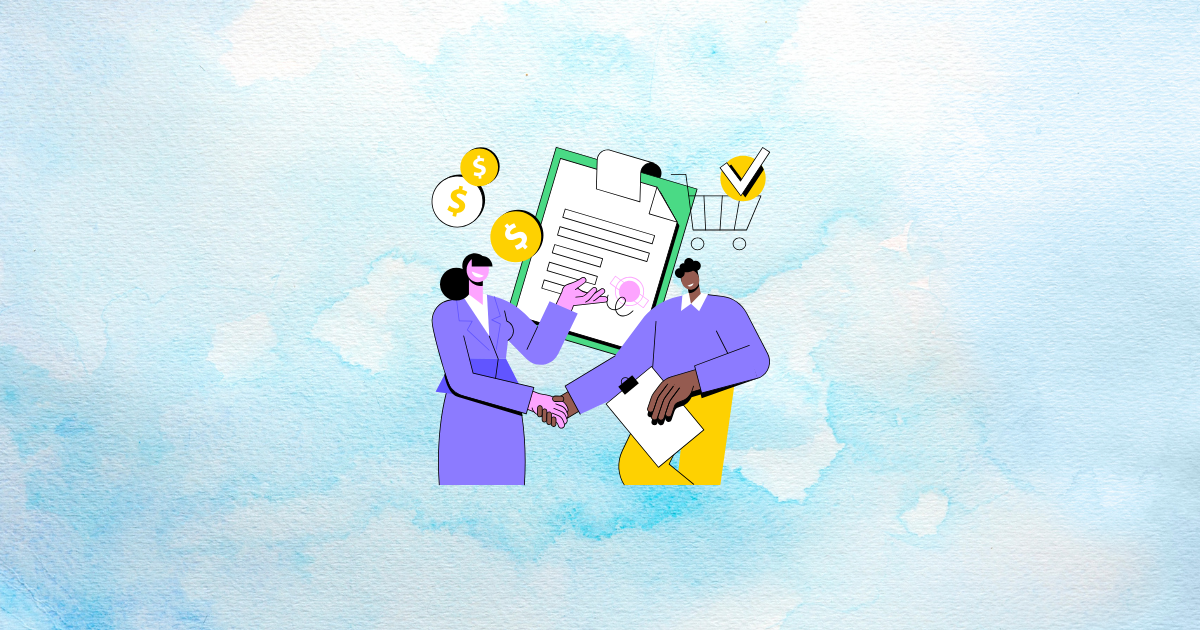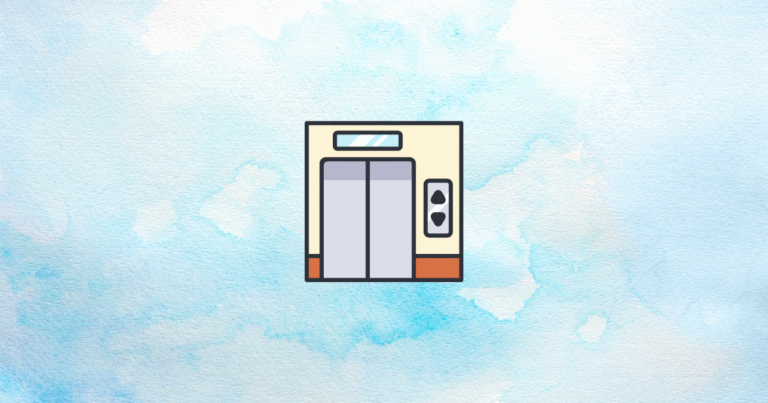Have you ever felt that warm glow of satisfaction after buying something special? That feeling when you can’t wait to show off your new purchase to friends, or when you feel genuinely good about supporting a brand that aligns with your values?
That feeling is post-purchase pride, and it’s far more powerful than most business owners realize.
While most marketing efforts focus on getting customers to click “buy,” what happens after the purchase can make or break your long-term success. Understanding how pride shapes customer behavior isn’t just interesting psychology—it’s a goldmine of opportunity for building loyalty, encouraging repeat purchases, and turning customers into passionate advocates.
In this article, you’ll discover:
- Why the human brain is wired to feel pride after making good purchases
- How leading brands like Starbucks and Nike strategically reinforce post-purchase pride
- Practical ways to measure and optimize pride in your customer journey
- Ethical considerations to ensure your pride strategies build authentic relationships
Ready to harness the hidden power of customer pride? Let’s dive in!
Psychological Foundations of Post-Purchase Pride
To effectively tap into post-purchase pride, we first need to understand why it exists in the first place. This section explores the deep psychological roots that make pride such a powerful emotion after buying something.
Cognitive-Emotional Mechanisms
Post-purchase pride isn’t just a nice bonus feeling—it’s actually part of how our brains justify our decisions. When we spend money on something, a small voice in our head might whisper, “Did I really need that?” Pride steps in as a powerful defender of our choices.
This works through something psychologists call cognitive dissonance reduction. Our brains don’t like the uncomfortable feeling of doubt after making a decision, so they look for ways to confirm we made the right choice. Pride serves as a convenient emotional shortcut that tells us, “Yes, you made a good decision!”
Think about the last time you splurged on something expensive. Chances are you found yourself pointing out its best features to friends or family. This isn’t just showing off—it’s your brain reinforcing your identity as a “good consumer” who makes smart choices.
Evolutionary Drivers
Our tendency to feel pride in our possessions isn’t a modern marketing invention—it’s deeply rooted in human evolution. For our ancestors, displaying valued possessions served as a signal of social status and resource access, which directly impacted survival and mate selection.
Even today, when we share photos of a new purchase on social media or display certain brands prominently, we’re participating in a modern version of this ancient status signaling. Our brains reward this behavior because, evolutionarily speaking, higher social standing meant better survival odds.
Cultural traditions around ownership, from housewarming parties to car-blessing ceremonies in some cultures, reinforce this pride in possession. These rituals aren’t random—they’re cultural expressions of deeply ingrained evolutionary drivers.
Behavioral Economics Framework
The way pride influences our purchase decisions follows predictable patterns that behavioral economists have identified. For example, the more pride we feel in a purchase, the more strongly we experience the sunk cost fallacy—our tendency to continue investing in something because we’ve already put resources into it.
Pride also helps mitigate loss aversion—our natural tendency to fear losses more than we value equivalent gains. When we feel proud of a purchase, the potential pain of “wasting money” diminishes because we’ve already framed the purchase as a positive reflection of our identity.
Perhaps most valuably for businesses, pride creates what we might call “loyalty loops.” When customers associate your brand with positive feelings of pride, they’re more likely to discount future costs (like higher prices) because the emotional reward outweighs the rational calculation.
Now that we understand why pride is so fundamental to how we feel about our purchases, let’s explore what’s actually happening in our brains when this powerful emotion takes hold. The neuroscience behind these feelings reveals even more opportunities to create meaningful customer connections!
Neuroscience of Post-Purchase Reinforcement
What exactly happens in our brains when we feel proud of a purchase? This isn’t just an academic question—understanding these neural mechanisms gives us powerful insights into creating more meaningful customer experiences.

Neural Reward Pathways
When you feel that satisfaction from a good purchase, your brain’s ventral striatum lights up like a Christmas tree. This is the same brain region activated by other pleasurable experiences like eating good food or receiving praise. It’s essentially your brain’s reward center saying, “That was a win!”
Interestingly, the prefrontal cortex—responsible for planning and decision-making—also engages during pride experiences. This suggests that pride isn’t just an emotional response but also involves self-evaluation and integration into our personal identity.
When we share our purchases with others, whether in person or on social media, our brains often release oxytocin—sometimes called the “bonding hormone.” This creates a powerful connection between social belonging and product ownership, explaining why unboxing videos and purchase-sharing on social media have become such widespread behaviors.
Cognitive Dissonance Resolution
Ever heard of buyer’s remorse? It’s essentially cognitive dissonance—that uncomfortable feeling when our actions don’t align with our beliefs. Neuroimaging studies show that the anterior cingulate cortex (ACC) activates when we experience this conflict.
Pride plays a crucial role in reducing ACC activity after a purchase, essentially calming the neural alarms that might otherwise flag our spending as problematic. This is why smart businesses focus on reinforcing good feelings immediately after purchase—they’re helping customers’ brains resolve potential dissonance.
Your brain also works to reconsolidate purchase memories through the hippocampus, gradually rewriting potentially negative aspects of the experience with more positive associations. When brands successfully trigger pride, they’re literally helping reshape how customers remember their purchasing experience.
Neurochemical Triggers
Pride experiences typically trigger a cocktail of neurochemicals, with dopamine leading the way. This powerful neurotransmitter reinforces the association between your product and positive feelings, creating a literal chemical reward for purchasing and using your products.
Social validation of purchases—like getting compliments on a new outfit or likes on a product post—boosts serotonin levels, which influences feelings of satisfaction and well-being. This explains why social proof is such a powerful component of post-purchase pride.
Perhaps most surprisingly, pride experiences can actually reduce cortisol—a stress hormone. In a world where consumers are increasingly stressed and overwhelmed, brands that successfully trigger pride may actually provide a biological stress buffer for their customers.
With these biological mechanisms in mind, let’s look at how pride actually shows up in real customer experiences. The different ways pride manifests offer unique opportunities to connect with your customers on a deeper level!
Post-Purchase Pride Manifestations
How does pride actually show up in customer behavior? Understanding these different expressions of pride helps us recognize opportunities to reinforce positive feelings throughout the customer journey.

Ownership Pride
The most basic form of post-purchase pride comes simply from possessing something desirable. This “pride of possession” is especially strong with products that allow personalization or customization. Think about how much more attached people feel to products they’ve had some hand in creating—from build-your-own furniture to personalized tech.
Collection completion is another powerful driver of ownership pride. When products are part of a series or set, customers often develop a strong desire to complete the collection. This is why collectible items, limited editions, and “gotta catch ’em all” marketing approaches work so effectively—each new addition reinforces pride in the growing collection.
Status signaling behaviors—like unboxing videos, social media sharing, or prominently displaying certain products—reveal how ownership pride often seeks social validation. Brands that make these behaviors easy and rewarding tap into a natural desire to share our pride with others.
Ethical Pride
As consumers become more conscious of their impact, ethical pride has emerged as a powerful force. Many customers feel genuine pride in supporting sustainable or socially responsible products, not just because of what the product does, but because of what their purchase says about them as people who care.
Social cause alignment, from Pride Month campaigns to racial justice initiatives, allows customers to express their values through their purchases. When done authentically, these connections create deep pride that goes beyond product features.
Cultural identity affirmation through conscious consumption is another growing manifestation of pride. Brands that respectfully celebrate cultural heritage or support underrepresented communities often generate strong pride responses from customers who identify with those communities.
Achievement Pride
Some products offer opportunities for customers to feel pride in their accomplishments. Complex products that require learning and mastery—from professional kitchen equipment to advanced software—generate pride when customers successfully use them.
Loyalty tier progression systems, like reaching “Platinum Status” or becoming a “VIP Member,” tap into our innate desire for achievement and recognition. Each new level reached creates a fresh surge of pride.
User-generated content creation—whether it’s sharing recipes made with your cooking product or artwork created with your software—allows customers to take pride not just in owning your product but in what they’ve created with it.
Now that we understand the different ways pride manifests in customer experiences, let’s explore strategic frameworks for deliberately designing pride moments into your customer journey. These practical approaches can transform casual customers into proud advocates for your brand!
Strategic Reinforcement Frameworks
How can businesses deliberately design experiences that reinforce customer pride? These strategic frameworks offer practical approaches to amplifying pride throughout the customer journey.
Pride-Centric Communication
The language and framing of your post-purchase communications can significantly impact customer pride. Instead of simply confirming an order, tell a story that emphasizes the customer’s agency and good judgment. “You’ve just joined thousands of smart homeowners who’ve chosen energy efficiency” feels very different from “Your order has been confirmed.”
Achievement framing of order confirmations and delivery updates can transform mundane transactional messages into pride moments. “Your expert-level cooking set has arrived!” creates more pride than “Your package has been delivered.”
Milestone celebration systems—recognizing purchase anniversaries, usage milestones, or membership duration—create periodic pride reinforcement long after the initial purchase excitement has faded.
Loyalty Program Design
Status-driven tier systems visible in customer profiles create ongoing motivation to maintain and elevate one’s standing. When these status markers are visible to others (like airline priority boarding or exclusive membership cards), they double as both personal pride boosters and social status signals.
Even the language used in your loyalty program can enhance pride. Compare the difference between earning generic “points” versus earning something branded that connects to positive emotions, like “Adventure Miles” for an outdoor retailer.
Community voting for exclusive rewards gives customers a voice in your brand while creating anticipation and increased value perception for the items they help select.
Social Validation Engineering
Shareable digital badges for purchase milestones or achievements make it easy and rewarding for customers to signal their status or accomplishments to others.
Customer spotlight programs that highlight interesting or successful users not only make those featured customers feel exceptional pride but also create aspiration in others.
User-generated content galleries with built-in social proof (like view counts or appreciation features) transform customer creativity into highly visible pride moments.
Product Experience Design
Customizable ownership certificates or personalized digital assets can transform intangible purchases into concrete symbols of ownership pride.
Progress-tracking interfaces for consumable products (like showing how much coffee you’ve enjoyed from your subscription) create ongoing awareness of the value received while building anticipation for the next delivery.
Collectible series with completion rewards turn individual purchases into steps in a larger, more pride-inducing journey.
These frameworks give us powerful tools for designing pride into customer experiences—but how do we know if they’re working? The next section explores how to measure pride responses and optimize your approach based on real customer data!
Measurement & Optimization
How do you know if your pride-building efforts are working? These measurement approaches help quantify the often intangible emotion of pride and optimize your strategies for maximum impact.
Neurometric Tracking
For businesses with sufficient resources, advanced neurometric tracking can provide direct insights into customer pride responses. While you’re unlikely to put your customers in fMRI machines, consumer neuroscience firms offer testing services that can evaluate how brain activation patterns respond to your post-purchase communications.
More accessible EEG measurement can detect emotional responses to your messaging, helping identify which elements trigger the strongest pride responses.
Even simple pupillometry (measuring pupil dilation) can detect spontaneous emotional responses, including pride, and is increasingly available through standard eye-tracking software.
Behavioral Analytics
For most businesses, behavioral metrics offer more practical insights into pride. Creating a Pride Engagement Index (PEI) that combines metrics like social sharing rates, repurchase velocity, and referral activity can provide a useful proxy for measuring pride.
Analyzing the correlation between customization depth (how much customers personalize products) and repurchase rates can reveal how ownership pride influences loyalty.
Social media sentiment analysis focused specifically on pride-related mentions of your brand or products can provide qualitative insights into how customers express pride in their purchases.
Predictive Modeling
As you gather more data, machine learning approaches can help personalize pride triggers for different customer segments. What makes one customer proud might differ significantly from another.
Pride metrics can also serve as early warning systems. Declining engagement with pride-building features often predicts churn before more obvious signals appear.
A/B testing frameworks specifically designed to evaluate pride reinforcement variants allow for continuous optimization of your approach.
Measurement is valuable, but sometimes the best insights come from examining real-world successes. Let’s look at how leading brands have masterfully implemented pride reinforcement strategies with remarkable results!
Case Studies in Pride Reinforcement
Theory is helpful, but seeing these principles in action brings them to life. These case studies showcase how leading brands have successfully implemented pride reinforcement strategies.
Starbucks Rewards Program
Starbucks has created one of the most effective pride-building loyalty programs in retail. Their coveted “Gold Level” status badges drive an astonishing 41% of company revenue from just 8% of their customers.
What makes their approach so effective? Starbucks combines visible status markers (the gold card) with personalized milestone celebrations that recognize individual customer journeys. By acknowledging “Your 100th latte” or “Your coffee-versary,” they create personalized pride moments that have increased customer lifetime value by an impressive 27%.
The program succeeds because it transforms routine coffee purchases into a journey of achievement and recognition—something customers can feel genuinely proud to participate in.
Nike Customization Ecosystem
Nike’s NIKEiD platform (now Nike By You) exemplifies how customization drives ownership pride. By allowing customers to design personalized shoes, Nike not only commands premium prices but has reduced return rates by 33% compared to standard products.
The shareable design galleries generate 18% of Nike’s referral traffic, as proud creators share their unique designs with friends and on social media.
Nike understood that people feel more pride in products they’ve helped create, and by making these creations shareable, they’ve transformed customers into brand advocates who drive new customer acquisition.
Patagonia Ethical Pride Campaigns
Patagonia has masterfully tapped into ethical pride by aligning their brand with environmental causes their customers care deeply about. Their transparency through detailed sustainability reports doesn’t just inform—it creates pride by association, increasing repeat purchases by 45% among first-time buyers exposed to their impact reporting.
Their innovative “Worn Wear” repair program encourages customers to maintain rather than replace products. While this might seem counterintuitive for sales, it’s actually boosted lifetime value by 62% by creating deeper brand affinity and pride in responsible consumption.
Patagonia shows that when customers feel proud not just of what they bought but what that purchase represents, they become deeply loyal advocates.
These success stories are inspiring, but implementing pride strategies also requires careful ethical consideration. Let’s explore how to ensure your pride reinforcement efforts build authentic relationships rather than manipulating customers.
Ethical Implementation Considerations
While pride reinforcement offers powerful benefits, it must be implemented ethically to build genuine relationships. These considerations help ensure your strategies create authentic connections rather than manipulative experiences.
Authenticity Requirements
When tapping into ethical pride through cause marketing, be vigilant about cultural appropriation risks. Superficial adoption of social causes for marketing purposes without meaningful commitment can backfire dramatically, creating cynicism rather than pride.
Similarly, “greenwashing”—making misleading environmental claims—can destroy trust when discovered. True sustainability pride must be backed by genuine practices and transparency.
Status-seeking behaviors can make some customers vulnerable to excessive spending or social pressure. Ethical pride reinforcement should include protections against exploiting these vulnerabilities, such as reasonable spending limits for status achievements.
Data Privacy Boundaries
Social sharing features should include clear consent frameworks that give customers control over what information is shared and with whom. Automatic posting or obscure privacy settings undermine the trust essential for pride.
If you collect neurometric data to optimize pride responses, maintain transparent standards about what data is collected and how it’s used. Customers should never feel their emotional responses are being monitored without their knowledge.
Behavioral nudging toward pride-inducing activities should maintain transparency about the intentions behind features. Hidden manipulation destroys the authenticity that makes pride meaningful.
Cross-Cultural Adaptation
Pride manifests differently across cultures, with some emphasizing individual achievement and others valuing collective contributions. Map these cultural pride dimensions to ensure your strategies resonate in different markets.
What constitutes a status symbol varies dramatically across cultures. Localized recognition systems should reflect cultural values rather than imposing one cultural standard globally.
Be aware of cultural taboos in how achievement is framed. What seems like innocent pride reinforcement in one culture might appear as inappropriate boasting in another.
Ethical considerations aren’t just about avoiding problems—they’re about building sustainable relationships that will endure into the future. Speaking of the future, let’s look at emerging technologies and approaches that will shape pride reinforcement in the coming years!
Future of Pride Reinforcement
The landscape of customer pride is evolving rapidly with new technologies and changing consumer values. These emerging approaches offer a glimpse into how pride reinforcement will transform in the coming years.
Emerging Technologies
Augmented reality is creating new possibilities for ownership visualization. Imagine customers using AR to see how their custom furniture designs will look in their actual living rooms before purchasing, or visualizing the impact of their sustainable product choices on environmental metrics.
Blockchain technology enables permanent pride ledgers that can verify authentic ownership of limited editions or track the entire ethical supply chain of a product. NFTs (Non-Fungible Tokens) have already demonstrated how digital ownership can generate significant pride.
Wearable technology increasingly includes biometric response tracking that could detect and respond to pride moments in real-time, potentially allowing products to adapt based on detected emotional states.
Predictive Systems
AI-powered pride trigger optimization will increasingly personalize post-purchase experiences based on individual psychological profiles, delivering precisely the right reinforcement at the right time.
As neural interface technology advances, direct pride calibration could theoretically optimize product experiences for maximum emotional reward while maintaining ethical boundaries.
Virtual environments like the metaverse are creating new spaces for digital “trophy rooms” where customers can display achievements and purchases in immersive social spaces designed for sharing and recognition.
Sustainability Integration
Circular economy pride incentives are transforming how we think about consumption by creating achievement systems around product repair, reuse, and recycling rather than just new purchases.
Innovative brands are developing repair/reuse achievement systems that gamify and reward sustainable behaviors, making responsible consumption a source of pride rather than sacrifice.
Carbon-negative purchase pride metrics allow customers to track the positive environmental impact of their choices, converting abstract concepts like “sustainability” into concrete achievements they can feel proud of.
As we’ve seen throughout this exploration, pride is far more than just a nice feeling—it’s a fundamental driver of customer behavior with enormous potential for building lasting relationships.
Conclusion
Throughout this journey into post-purchase pride, we’ve discovered how deeply this emotion is wired into human psychology and behavior. From the neurochemical rewards that reinforce purchase decisions to the varied ways pride manifests in customer experiences, we’ve seen how powerful this often-overlooked emotion can be.
The strategic frameworks we’ve explored offer practical approaches to designing pride-inducing moments throughout your customer journey. Whether through carefully crafted communications, thoughtfully designed loyalty programs, or innovative product experiences, there are countless opportunities to transform routine transactions into meaningful pride moments.
As with any powerful tool, pride reinforcement comes with responsibility. By maintaining authenticity, respecting privacy boundaries, and adapting sensitively to cultural contexts, you can ensure your pride strategies build genuine relationships rather than manipulative experiences.
Looking ahead, emerging technologies and changing consumer values will continue to transform how brands create and reinforce customer pride. Those who understand and ethically implement these approaches will build the kind of deep emotional connections that transcend traditional loyalty.
Remember: Shopify store owners can easily implement many of these pride reinforcement strategies using the Growth Suite app, helping transform one-time purchasers into proud, loyal advocates for your brand.
References
- Johnson, M. (2014). How embarrassing is that? Purchasing sensitive products and the role of self-service technologies. [PDF]
- Sarney, C. (2023). The Power of Brand Pride. LinkedIn. https://www.linkedin.com/pulse/power-brand-pride-marketers-imperative-carl-sarney
- PMC. (2013). Neuromarketing and consumer neuroscience. https://pmc.ncbi.nlm.nih.gov/articles/PMC3626833/
- Lingble. (2023). Pride Month Marketing. https://www.lingble.com/blog/marketing-for-pride-month-how-ecommerce-brands-can-show-their-support-en/
- PMC. (2009). Cultural Pride Reinforcement. https://pmc.ncbi.nlm.nih.gov/articles/PMC2749692/
- FasterCapital. (2024). Post-Purchase Behavior. https://fastercapital.com/content/Post-purchase-behavior–Beyond-the-Sale–Examining-Post-Purchase-Behavior-in-Consumer-Decision-making.html
- Combeenation. (2018). Pride of Ownership. https://www.combeenation.com/en/blogs/details/pride-of-ownership-wenn-stolz-zu-umsatz-fuehrt/




